
Gallery Director - Alan Garfield
On the occasion of World Art Day (April 15, in case you didn’t know either), the Director of UNESCO, Audrey Azoulay, said “Bringing people together, inspiring, soothing and sharing: these are the powers of art, the importance of which has been made emphatically obvious during the COVID-19 pandemic”. Actually, I’m not convinced that art’s importance is now more (or less) obvious now that we’ve traveled 6 months into this pandemic. Personally, I can’t testify to inspiration or soothing at this point in time, but I can document how our daily lives have dramatically changed. So what about the state of current artwork?
In times of crisis, we need culture to make us resilient, to give us hope, to reflect upon our choices. Currently, politicians – always the first to speak – contribute little to our fine art well-being. As for me, I prefer to see messages in aesthetic presentations.
The thesis of this show is a simple, declarative statement. Artists, please show us some examples of what you have been making during the pandemic. The answers, quite obviously, are all over the place. Some artists have taken a very firm political road, some have combined the Covid presence with Black Lives Matter, some are working as they always have and you’d be hard put to see a Covid effect on their work. This invitational is a complete smorgasbord of imagery. Though small, our Gallery sports the beauty of nature vs beer cans in nature. (Welcome to modern life.)
I asked all the artists (from age 9 to 70) to write a statement, which you’ll find next to their work. Perhaps those statements will act as mini-manifestos, or perhaps they will be confusing. Good art needs neither to speed up nor to slow the pulse. It simply needs to make you aware of it.
Whatever else that might be said about this pandemic, it is clear that art organizations, artists, venues and audiences are staring down a lot of uncertainty. Galleries have permanently closed; museums worldwide are laying off many of their curators. Theatres and musical venues have gone dark. What I do know, a hopeful sign perhaps, is that every artist I invited jumped at showing work. We have works hanging in the Bisignano Art Gallery from Iowa City, IA, Pittsburg, PA, and various cities in Wisconsin and Iowa. I included various current and former students, even my grandson. The pandemic affects us all, in so many different ways. Some of the works are rather traditional, some are clearly mad at our new reality, some are sarcastic. There is, of course, no overriding aesthetic being demonstrated in the Art during the Pandemic. Art is often defined as an interpretation of reality, and the artists’ realities are all so very disparate. What we know from this show, though, is that creativity abounds. And that will have to be good enough for now.
Unlike past times, there is no opening for this show. No food, no chat between the artists, students, faculty or the community of Dubuque. We’re not organizing group visits nor having an artist’s panel. You either choose to visit the Bisignano physically or you visit our webpage (http://gallery.dbq.edu) for the show (or both). In any case, we thank you for visiting and for being part of this snapshot of our time. Stay safe.
Jeff Ackley

Living through a pandemic was the last thing I was thinking about when trying to plan something fun for my wife's 33rd birthday, but here we are. When the mass hysteria started in March 2020, I had to think of a fun way to make light of the situation, and the idea of COVID Cupcakes was born.
I believe that the two best ways to cope with anxiety and fear are by breaking bread and humor. The acts of breaking bread and humor bring people together, break down walls, and display our real qualities as human beings -- maybe we are all not so different. Breaking bread and humor are powerful tools, but when combined, the merits of these tools are amplified.
As human beings, we have an intrinsic need to be together; let's face it; we are social animals. At the beginning of the pandemic, this notion of social distancing was difficult for most of us, running out of toilet paper was many peoples biggest fear, the idea of a face mask as a loss of freedom, and an invisible virus that has the potential to kill us.
Due to these fears, I realized that we needed a bit of humor in our lives and a way to cope with what soon will become our new normal. We all need something to make us laugh, but also bring us together, and that is how COVID Cupcakes were born.
Matt Bonsall
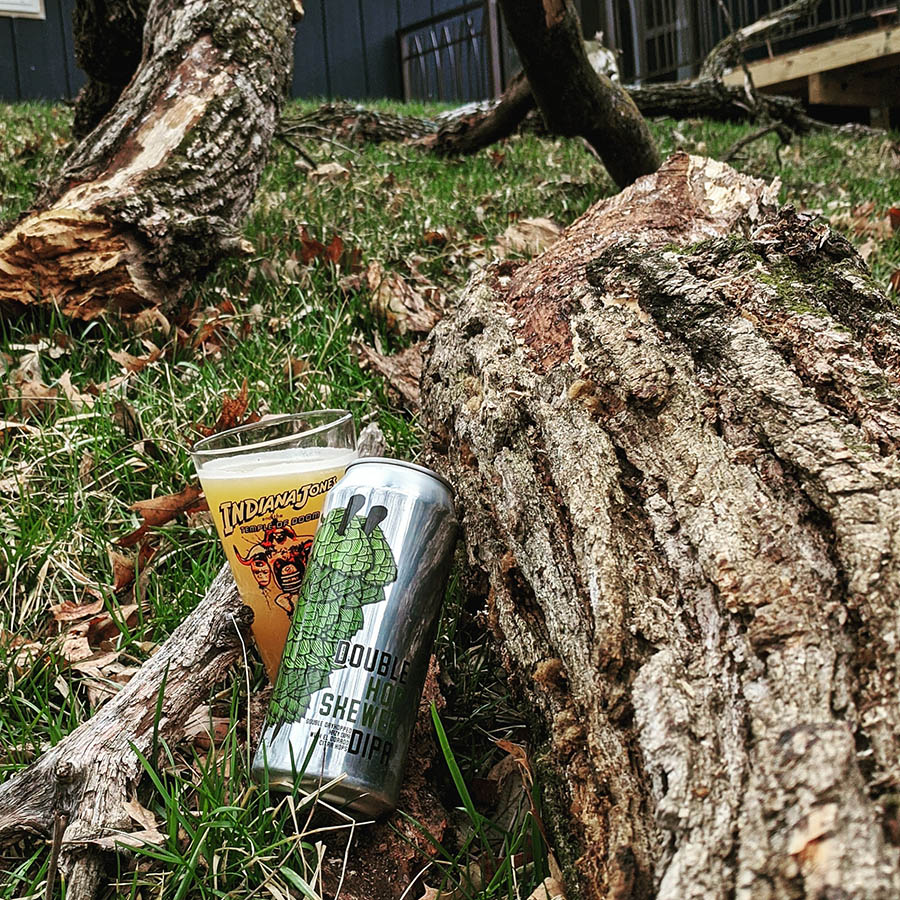
From my perspective, my work doesn’t really relate directly to COVID-19 or the pandemic. I have created works like the two main series I’ve created here before the pandemic and I continue now. I received a BFA in Photography from Iowa State and I found an interest in combining my love of craft beer and nature photography. So that is what I photograh, craft beer in nature. I take many photos, never printing them out, and simply posting them on my Instagram page. (On Instagram, I’m “beermoines” – like Des Moines where I live but substituting beer for des.)
And as far as my toilet paper roll sculpture goes, I got the idea while visiting the Princeton University Art Gallery and seeing Don Judd’s shiny bronze untitled piece from 1988. The work is a series of 9 shiny, solid bronze rectangles attached vertically to a wall with space in-between. Judd was a Minimalist sculptor. At the point I created it, early in the Spring, I was reading that people should try to take household items and recreate artworks at home. So, that’s what I did.
Teresa Boxleiter
“In light of recent events I felt compelled to issue a statement expressing my deep disappointment at how my actions have been received. If the unintended consequences of my actions have led to anyone feeling hurt I am deeply regretful of those feelings. This isn't representative of who I am and this isn’t representative of how I have been raised. I will now step back and take a long time to listen. I hope someday you will be able to see me for who I really am. Until then, please respect my need for privacy and solace in these troubled times.”
Noah Bullock
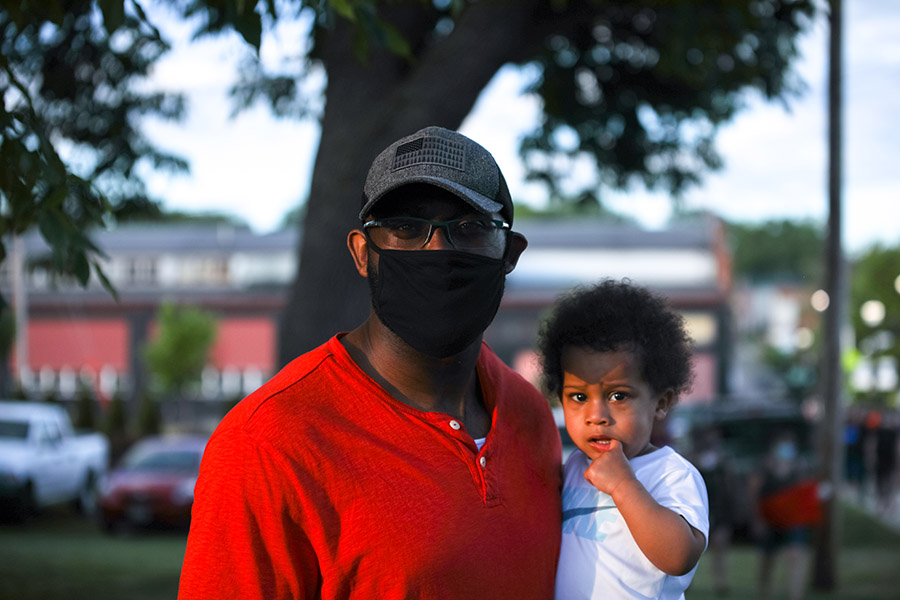

Today we are living through uncertain times, maybe even apocalyptic in nature. Being quarantined and wearing a mask is the new norm. Grocery stores are empty, some people are running out of toilet paper and having to resort to less modern conveniences and finally were all just going a bit crazy. Covid-19 swept the world with its devilish intent killing countless numbers of Fathers, Mothers, Children and everyone else in between.
Meanwhile three months into the pandemic, a man named George Floyd was brutally murdered by a police officer in Minneapolis, MN and thus the BLM movement took charge. There have been thousands of protests all around the world in the name of “Black Lives Matter”.
So through all this chaos I decided to embark on a project unlike anything I’ve ever done. I wanted to document the good sides of Covid-19 and BLM. But what good has come out of all of this? Through my photos I’ve tried to show how we’ve come together as a community, especially in my small hometown of Dubuque, IA. Community. Maybe that’s what we’re seeking to reclaim, in a new way, in what we hope will be a post-pandemic world.
Britni Farber

“It makes me cry” is the first piece in a working series of artwork that bears witness to the silent disconnect felt between expressing or the inability to express one’s internal emotions to fluid external thoughts.
The context of my work begins with the yearning to suppress somatic symptoms of emotional distress and my desire to communicate feelings in a way that I could not convey other than saying, “it makes me cry.”
While creating this piece, I found my hands to be a powerful working tool, giving a voice to my unspoken visceral feelings. By using hands, I’m able to find a sensory release which then translated into the grit of the painting and the display of my core emotions during a time when verbal expression felt lost.
Alan Garfield
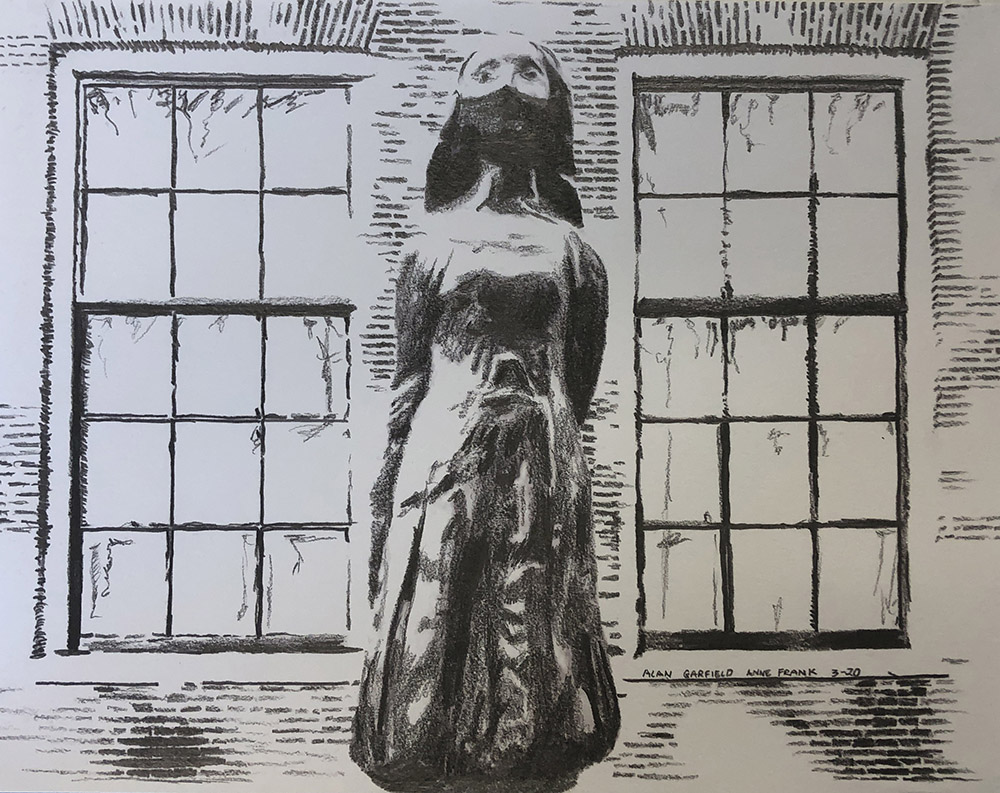

Anne Frank Statue with Mask drawing. On March 11 at 2:30am, I was sitting in my Amsterdam hotel room drawing this picture of Anne Frank, the 13 year old Jewish Dutch girl whose diary many have read. Earlier that day, I brought our students (on the International Studies trip to The Netherlands and Belgium) to the Anne Frank house to experience that Secret Annex. I remember the exact time I was drawing because that is when my wife, in Dubuque, called me and told me that the President was closing the borders to the US in a day and I better do something quickly. I did. Needless to say, I didn’t finish the drawing until I got the students back to the University. And by the time I did, sitting at home in Dubuque, the world had changed. Everyone was wearing a mask, or at least was encouraged to wear a mask, to be thoughtful for the safety of the people around them. As I was finishing the drawing of that statue (it’s in a little park next to Westermarkt 20), I decided to put a mask on her, too. My drawings tend to be rather dry, very naturalistic (I never really enjoyed much abstraction), and I love to focus on negative space. Here in this work, I enjoyed the Dutch brick, which is very different from the brick we make in the US. It is long but not very high (maybe 1 ½ inches). I hope you get a sense of it since it is the architectural basis of this drawing.
Triple Self Portrait with Mask. My second drawing is a 3-part self-portrait. Many years ago, I used to love drawing faces (adults, children, even pets). They paid the rent. But at some point I switched to panoramic landscapes. I love the way the British Victorian artists could capture miles of light and shade in a small format drawing or watercolor wash. I created this self-portrait after putting a rather direct ‘Why I Wear a Mask’ on my office door. I love negative space, as you might be able to tell here in this drawing.
Jensen Garfield
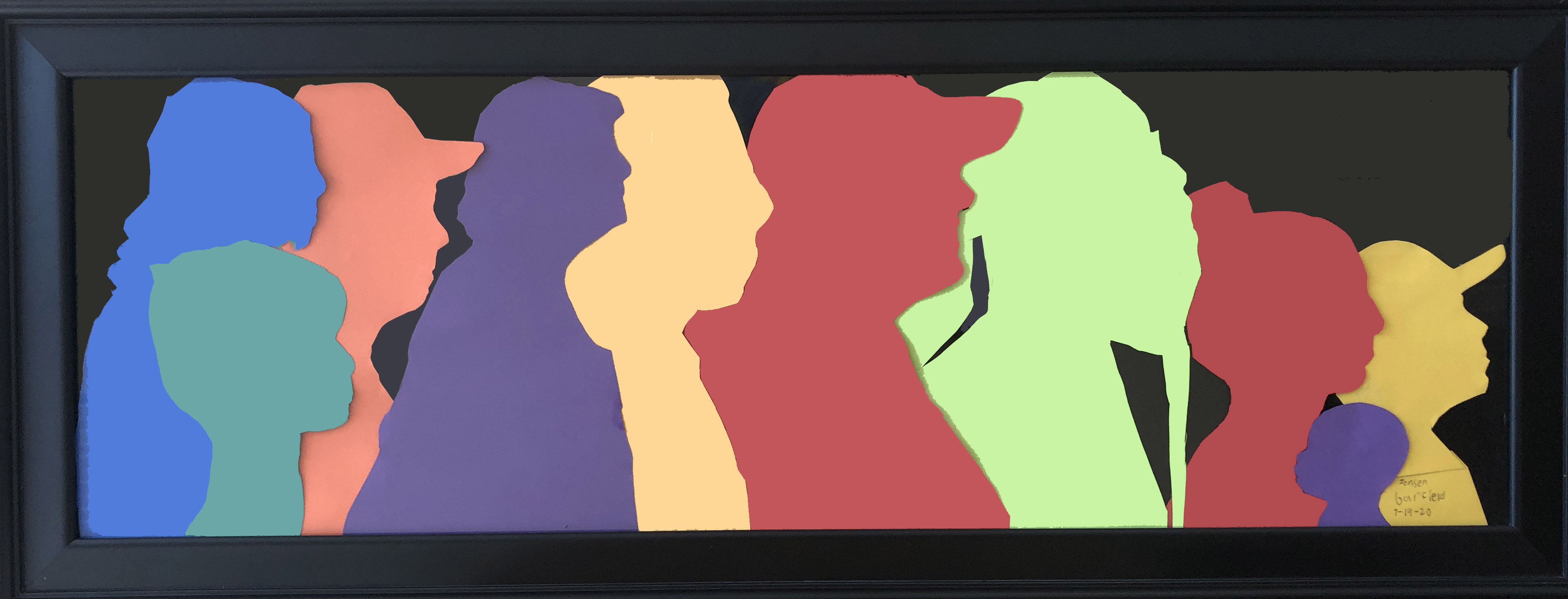
These 10 silhouettes are of my family (aunts and uncles and one baby cousin included). Originally, I did a drawing of frowning stick figures: my Mom, Dad and me. We were frowning because of the COVID-19 pandemic. It sucks. We can’t be together, we have to be separate. So I decided to make us all together.
I’m 9 so I didn’t think I could actually do this. First, I took a picture one-at-a-time of my family members. Then my Zayde printed them out. I wanted them to be colorful silhouettes, not just black and white silhouettes. Color would make it more interesting. Also, we are all different people so why not use exciting colors. The colors don’t have a meaning. I wanted them to be colorful. Then I carefully cut out the outlines of each family member. I had 3 scissors and tried each one until I figured out which one was best. Then I arranged the silhouettes in the frame, grouping them. First came my Mom, Dad and me, then Bubbe and Zayde, then Aunt Becca and Uncle Eliot and finally Aunt Carly, Uncle Andy and my baby cousin Leopold. I practiced signing it on a piece of scrap paper and then signed and dated this on Andy’s silhouette.
I am excited to show this art work. I hope people like it and understand it better after reading this.
Barbara Arnold Heitzman
My concept of ‘time’ has changed during this pandemic. The hours, days, and weeks blur together as our country and world step into the unknown.
Family, friends, and community activities have stopped or are severely diminished. It is Zoom, masked air hugs, curb-side grocery, and binging on the news. But I know I am privileged. I have the ‘time’ to work on my art, in my garden, and enjoy the birds who visit our feeders.
Ali Hval
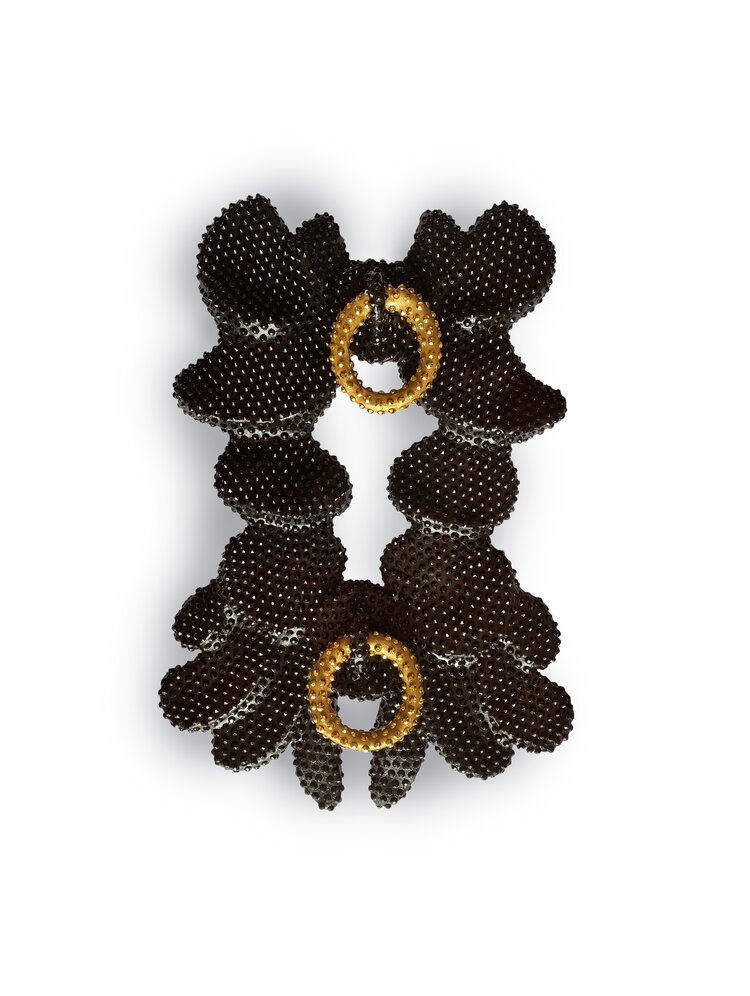
My pieces have transformed from those without “door knockers” to those with them during the pandemic. Preventative measures are now being made before exiting one’s place of residence or in regards to being near others, and the door knocker has become a metaphor for the spectrum of precautions people are taking during COVID-19. There are now certain actions in place that we have to do before doing another action we would previously do: sanitizing hands after going to the grocery store, calling ahead to pick-up an order outside an establishment, and putting on a mask before leaving home.
Though much of what I do is rooted in public art and that part of my practice was relatively unaffected, other parts of my life shifted: I began sewing masks in March, teaching remotely, and drastically reducing my interactions with the outside world. All of these things added an extra layer of isolation that already comes with being an artist, but this pandemic has also shifted the way I think about how others view my work. Now, I am more conscious of how my work is shared digitally and through what platforms, as well as further understanding the importance of keeping those social media platforms more engaged with what I am doing—including all the transparency and honesty behind the work I make. Doing so has strengthened relationships with artists I have never met, and I have found myself facetiming and/or zooming during the pandemic with people who I had followed on Instagram and enriching my studio experiences in a new way.
Andrew Ellis Johnson
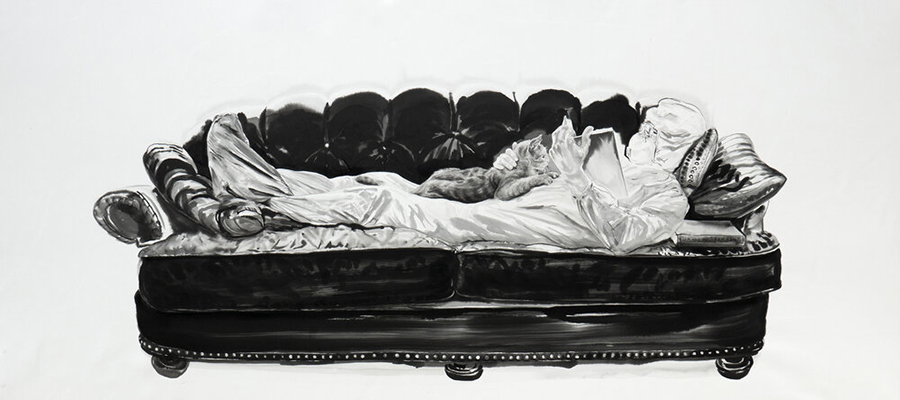
Andrew Ellis Johnson Statement:
Insurrection (above) is named after Insurrecto by Gina Apostol, a novel read and set aside behind the reader’s sterile shoulder. Its story begins under the current presidency of Rodrigo Duterte, a dictator who has encouraged extrajudicial killings. Not surprisingly, this president has been praised by our own president, who seems a kindred bully. With the unrest that followed George Floyd’s murder in Minneapolis, Trump tweeted “when the looting starts, the shooting starts.” Apostol’s Insurrecto is a feverish narrative about a small Filipino town’s insurrection against American oppressors. Fevers are insurrections of the body against infection and illness. We have illnesses of all kinds—medical, social, and economic. Too many are chronic. Certain fevers need to spread—to burn out ignorance and injustice.
In the exceptional Nation State of One,
the novel plague,
first declared nonexistent,
then decried as sophic,
was ultimately decreed ‘Democratic’.
It was.
Though itself invisible to the naked eye,
the virus, though little,
spread by aspirational spittle,
magnified divisions and bonds.
Manufacturers mandated.
Distributors consolidated.
Liberators looted.
Suppliers hoarded.
Senators sanctioned.
the unaffordable could be bought again.
Sacrificial heroes, ill-suited, staved,
for another quarter,
the essential economy.
Perhaps.
Routines were screened.
Meetings multiplied and merged.
Unemployment ranks swelled.
Curves flattened; feeds fed.
Appropriations diverted.
Tweet-enlisted fascists drilled.
Unmasked.
Indisposed Justice meted
black breath no repose.
The State of Stasis
is fought within, and without.
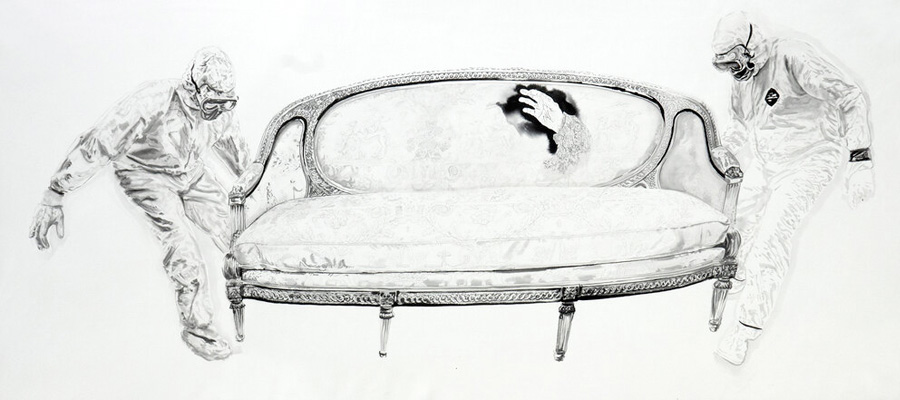
::: top :::
Joe Kelley
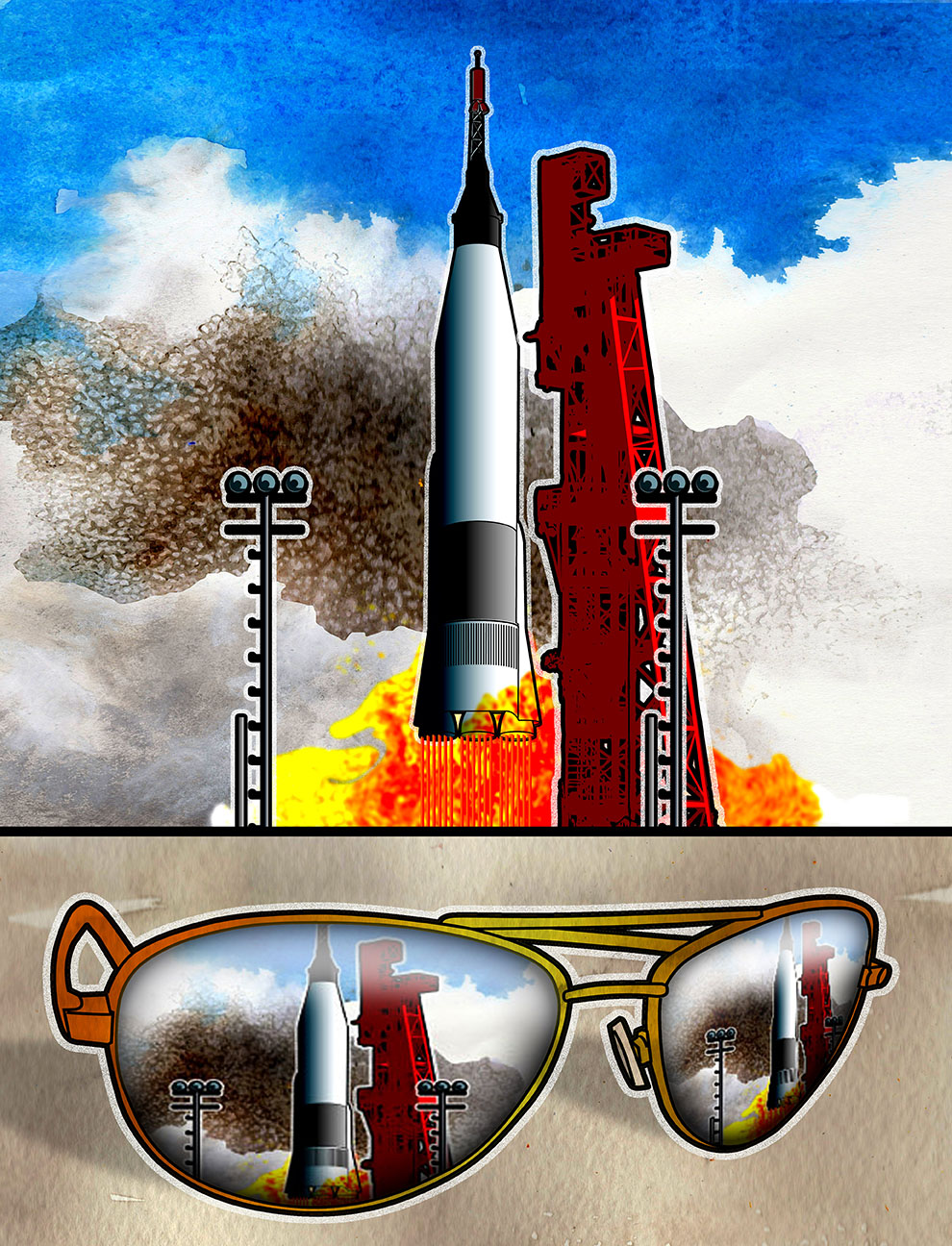
I ran across a May 18, 2020 article in the Washington Post titled “Having coronavirus nightmares? Here’s what you can do about those bad dreams.” (by Galadriel Watson). This story reported that people across the country were experiencing an enhanced dream life since the start of the pandemic. Many said that their dreams were unusually vivid and memorable. This struck a chord with me since my dreams for the past few months had been pretty strange and vivid as well.
The story went on to say, "There’s an uptick in dream life right now, which happens a little bit after any crisis," says Deirdre Barrett, a dream researcher and assistant professor of psychology at Harvard University. "A crisis like this 'stirs up our dreams,' whether this means you experience more vivid dreams, more emotional dreams or more bizarre dreams.”
My dream life has run the gamut from, shaking someone's hand and then, in a panic, looking for hand sanitizer, to smoking cigars and drinking brandy with Winston Churchill. The illustration offered here, Pandemic Dream #62, is a snippet of one dream that seemed especially odd. As the pandemic moves through our lives we all face the world with a bit of fear and loathing. This has taken its toll on our body and mind. The expression of those feelings has to be worked out in one way or another. I for one have been thankful that, at least, in my dream life I have been entertained.
Katie Larson
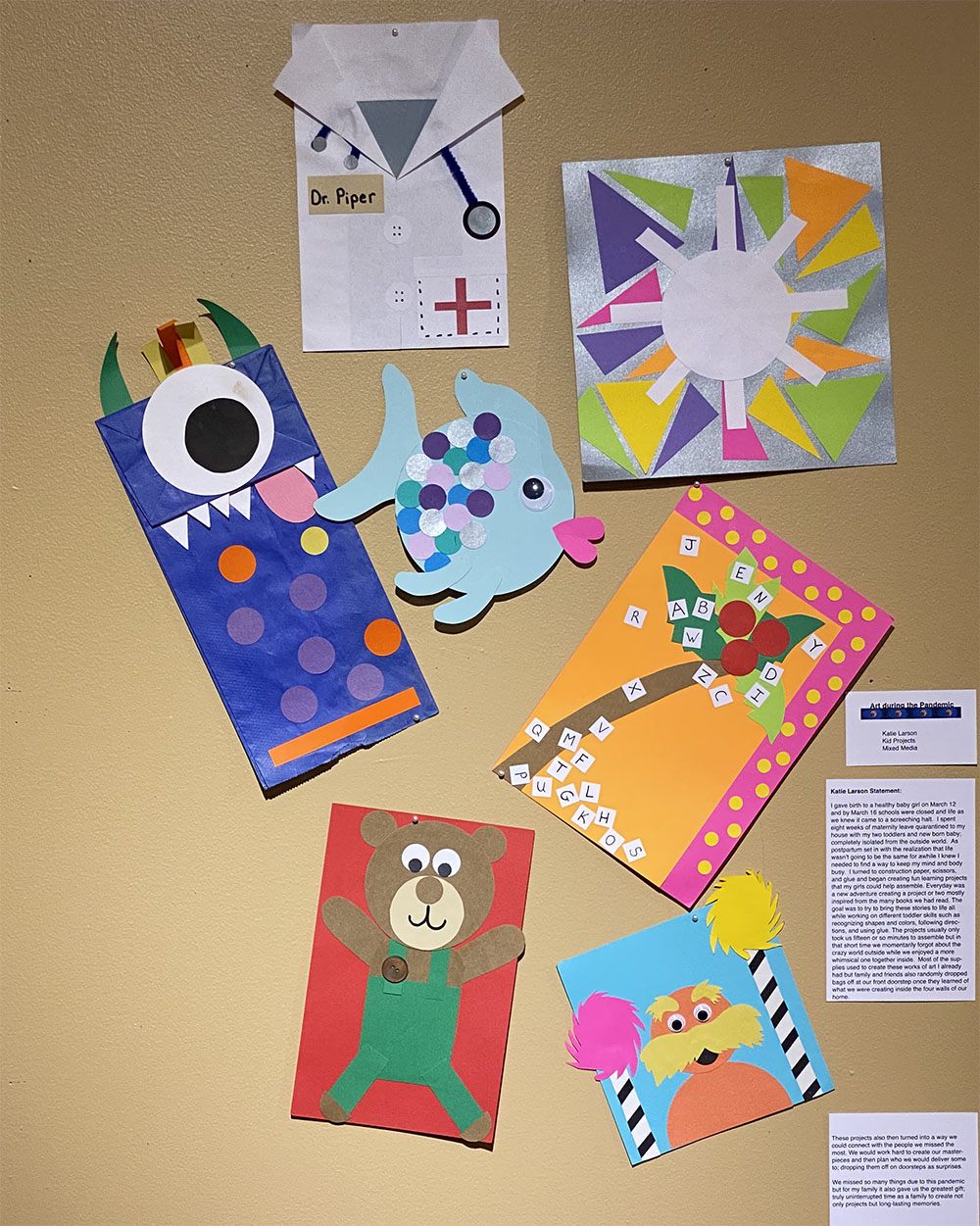
I gave birth to a healthy baby girl on March 12 and by March 16 schools were closed and life as we knew it came to a screeching halt. I spent eight weeks of maternity leave quarantined to my house with my two toddlers and new born baby; completely isolated from the outside world. As postpartum set in with the realization that life wasn’t going to be the same for awhile I knew I needed to find a way to keep my mind and body busy. I turned to construction paper, scissors, and glue and began creating fun learning projects that my girls could help assemble. Everyday was a new adventure creating a project or two mostly inspired from the many books we had read. The goal was to try to bring these stories to life all while working on different toddler skills such as recognizing shapes and colors, following directions, and using glue. The projects usually only took us fifteen or so minutes to assemble but in that short time we momentarily forgot about the crazy world outside while we enjoyed a more whimsical one together inside. Most of the supplies used to create these works of art I already had but family and friends also randomly dropped bags off at our front doorstep once they learned of what we were creating inside the four walls of our home. These projects also then turned into a way we could connect with the people we missed the most. We would work hard to create our masterpieces and then plan who we would deliver some to; dropping them off on doorsteps as surprises.
We missed so many things due to this pandemic but for my family it also gave us the greatest gift; truly uninterrupted time as a family to create not only projects but long-lasting memories.
Tyler Nash
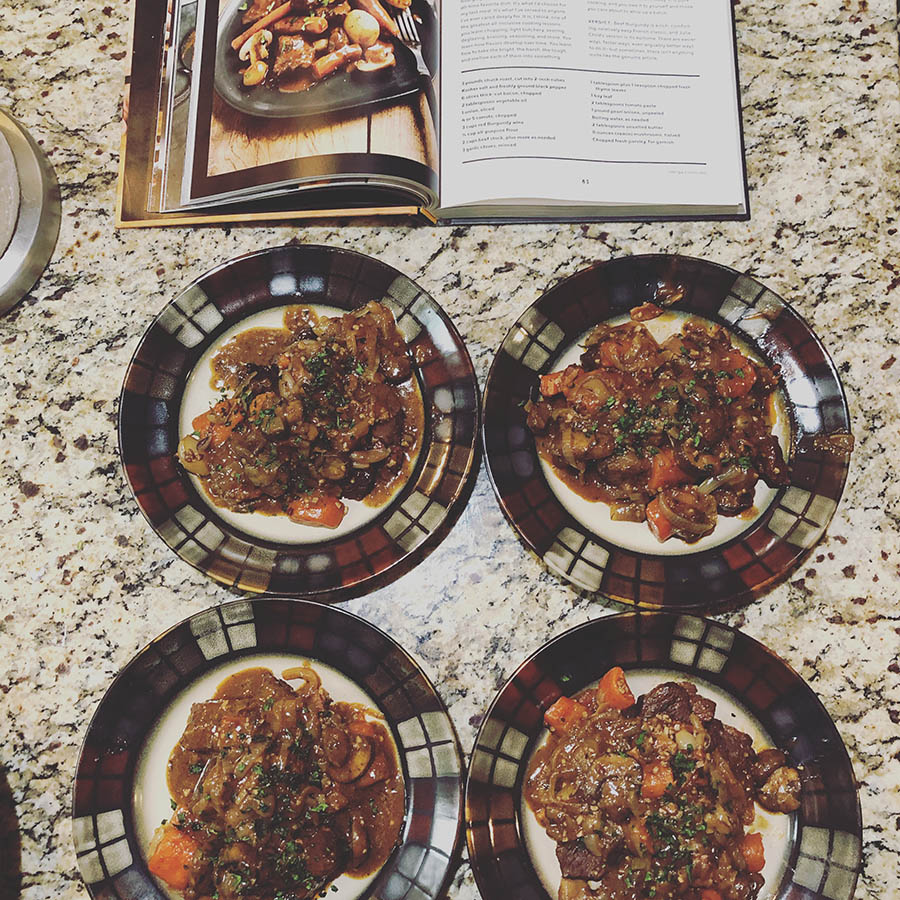
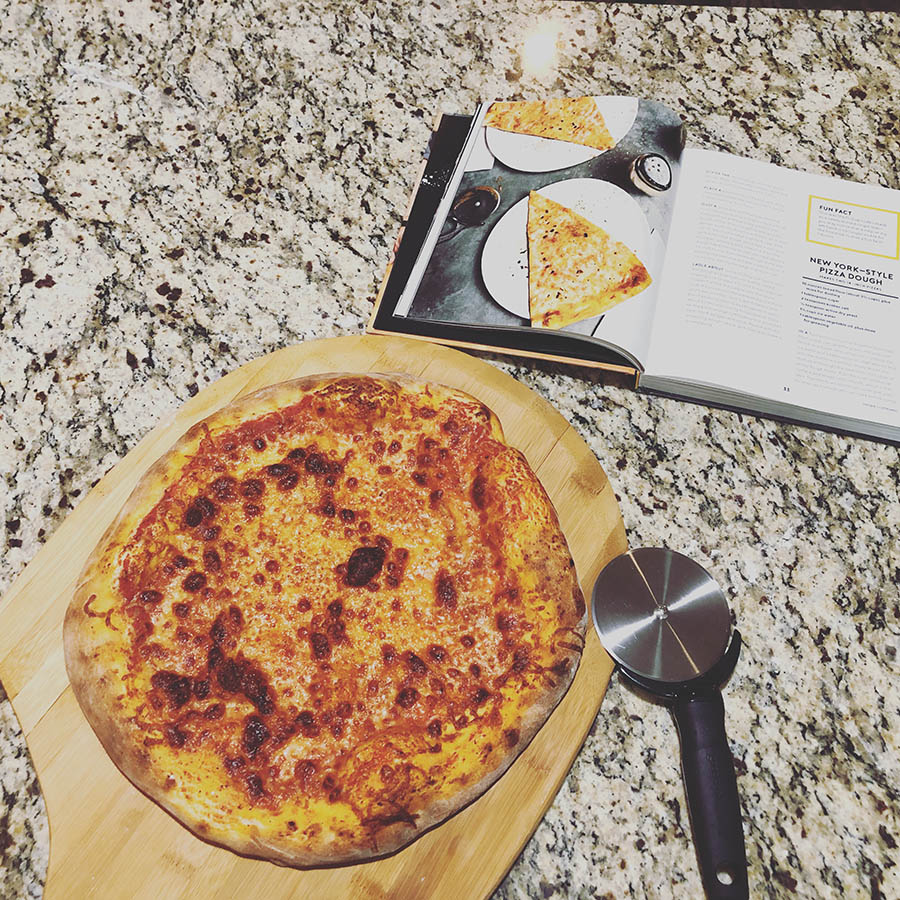
“Why is everyone making sourdough bread?” I asked myself this question while feverishly looking for dry yeast to use in my from-scratch NYC-style pizza recipe. 5 stores later and I struck gold. Last packet on the shelf. Hallelujah!
While many were jumping on the “what-to-occupy-myself-in-quarantine” train when all of this started, I was already chugging along on a passion project of my own. At the start of the year, I decided that I was going to dust off my cookbooks I’ve accumulated over the years and get to know my kitchen more. 52 meals (at least) in 52 weeks utilizing those cookbooks.
I came from a culinary household where food was a religion and cookbooks were scripture. But like a little kid at church, I never took much heed to it and took my parents’ skill in the kitchen for granted. This challenge was a test to see if all those years of being exposed to food and the kitchen actually stuck. I was being born again, if you will.
I had quite a few recipes under my belt when COVID-19 hit. Beef and Guinness Stew, Tampopo-style Ramen, Boeuf Bourguignon, NYC-style Pizza. I was on a roll. Then I started to refocus. If there was one thing I can take away from being in the kitchen during this pandemic is this; cooking for yourself is only satisfying to one person. Cooking for others is satisfying to all. While I found passion in what I was doing for myself, nothing felt more rewarding than making food for others in my home. The look of joy I get from my wife when I have her taste this week’s meal is all I need to keep me going.
Mark Neyens
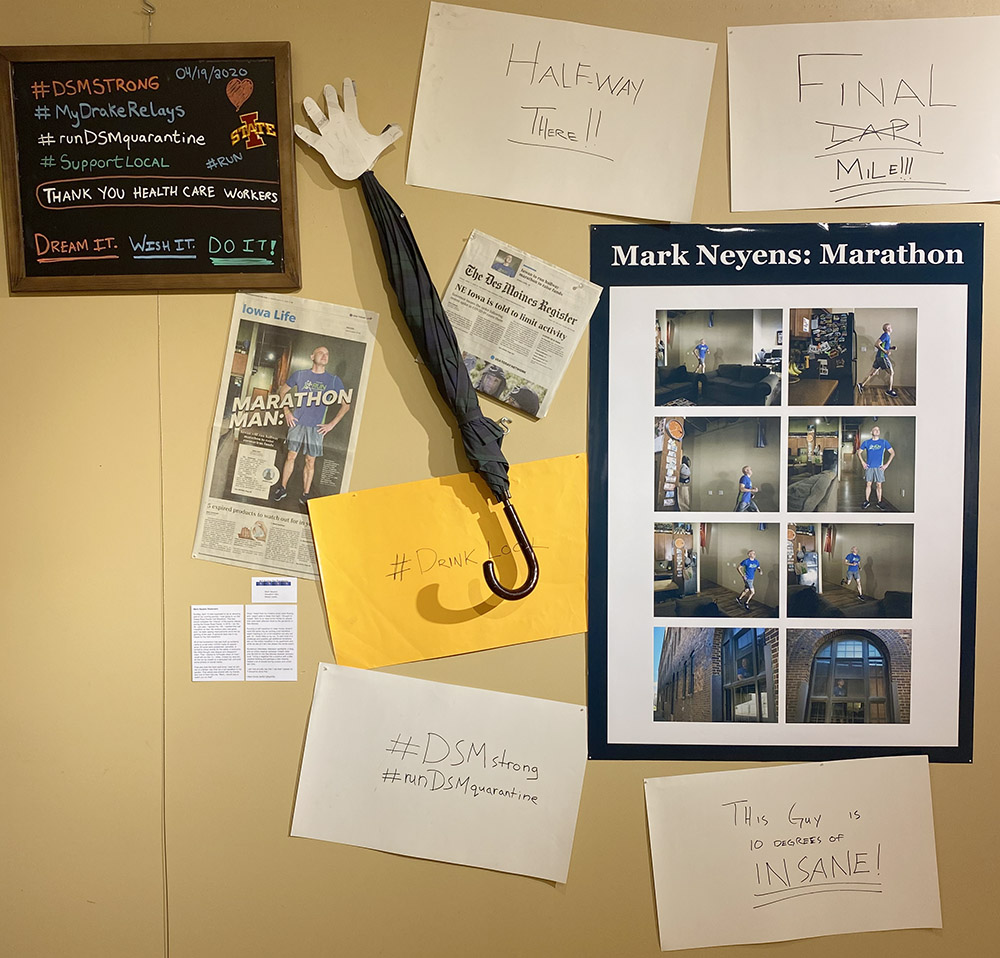
Sunday, April 19 was supposed to be an amazing part of my running journey. I was going to run the Drake Road Races Half Marathon. This feat would complete the “trifecta” of the events offered during the Drake Road Races. In 2018, I ran the 5k. Last year, I tackled the 10K. I wanted that half marathon so bad. My workout plan was great, and I’ve been seeing improvements since the beginning of the year. A personal best was in my future for the half marathon!
All of the momentum that was built up suddenly came to a halt when COVID made its appearance. All races were postponed, canceled, or turned to virtual events for the safety of everyone. My initial thought was disgust and disappointment. Then I started to formulate ideas on how I could still run the 13.1 miles. Create my race bib, do the run by myself on a secluded trail, and post some photos on social media.
That plan took the back seat once I read an article on a British man that ran a full marathon in his garden. That article was shared with my friends and one of them told me, "Mark, I would pay to watch you do that!" Once I heard that my creative juices were flowing and I wasn't able to sleep that night. I thought to myself, "let's try to raise some money for people that have been affected most by the pandemic in Des Moines.
Running a half marathon to raise money doesn't have the same ring as running a full marathon. I wasn't training to run a full marathon but why not add 13.1 more miles to my run. To add more of a challenge and possibly get additional donations lets run the entire marathon in my apartment and while we are at it let's live stream the whole event.
Numerous interviews, television spotlights, a blog, and an entire creative campaign helped raise over $4,000 for the Des Moines disaster recovery fund. Turing a negative into a positive with a little creative thinking and perhaps a little insanity helped a lot of people during a scary and uncertain time. I can now proudly say that “I did that!” instead of, “I should’ve done that.” https://youtu.be/SyYg6yjp2Qs
::: top :::
Debra Runkle

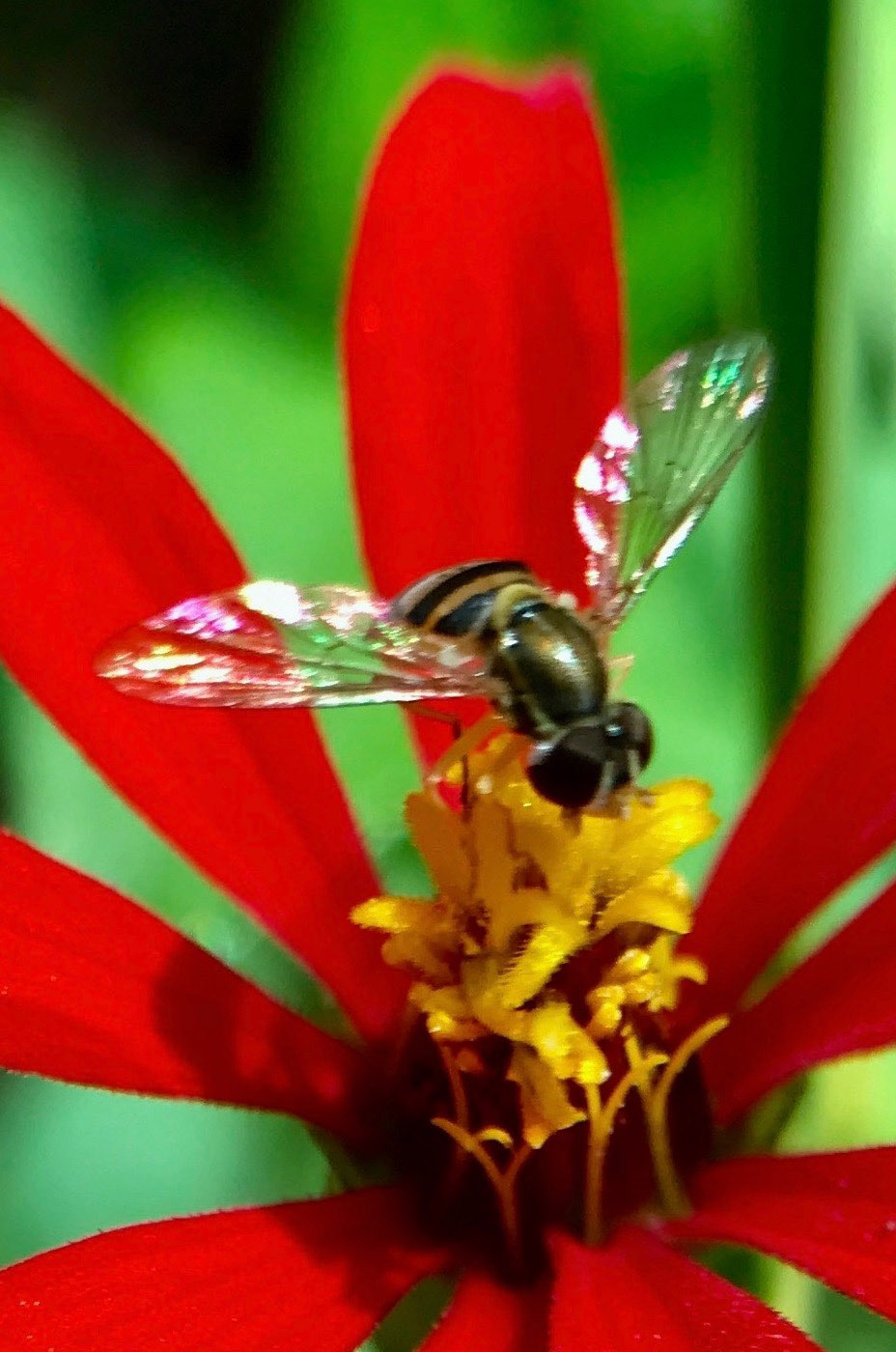
My pieces have transformed from those without “door knockers” to those with them during the pandemic. Preventative measures are now being made before exiting one’s place of residence or in regards to being near others, and the door knocker has become a metaphor for the spectrum of precautions people are taking during COVID-19. There are now certain actions in place that we have to do before doing another action we would previously do: sanitizing hands after going to the grocery store, calling ahead to pick-up an order outside an establishment, and putting on a mask before leaving home.
Though much of what I do is rooted in public art and that part of my practice was relatively unaffected, other parts of my life shifted: I began sewing masks in March, teaching remotely, and drastically reducing my interactions with the outside world. All of these things added an extra layer of isolation that already comes with being an artist, but this pandemic has also shifted the way I think about how others view my work. Now, I am more conscious of how my work is shared digitally and through what platforms, as well as further understanding the importance of keeping those social media platforms more engaged with what I am doing—including all the transparency and honesty behind the work I make. Doing so has strengthened relationships with artists I have never met, and I have found myself facetiming and/or zooming during the pandemic with people who I had followed on Instagram and enriching my studio experiences in a new way.
Zander Saleh

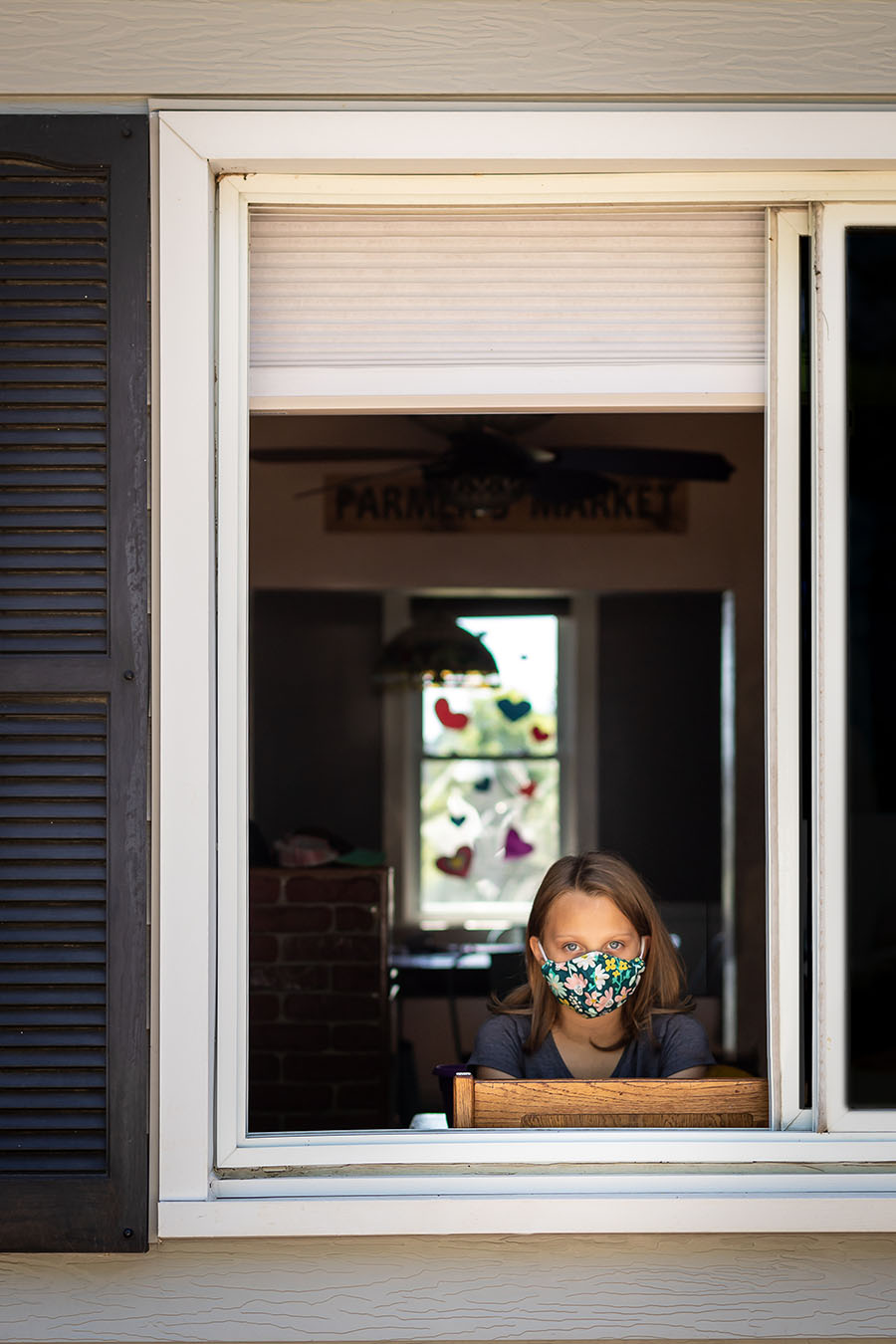
COVID-19's lesson for me, at first glance, is to enjoy the little things in life, for only when they are gone do we realize they were the big things.
However, after more reflection on our current circumstances, I feel also that we must stop using pleasant sentiments to mask hard truths. COVID-19 and our response to it have exposed our selfish nature. We have placed a higher value on personal comfort than we have on the lives of vulnerable people.
We refuse masks, refute facts, and remain silent all in the name of comfort. Nostalgia clouds our judgment and tells us if only things could go back to "normal" life would be good again.
As you look at my photos, please do not think about how things were. Instead, think of what our future can be. We must not work to go back to what life was before; we must keep our failures exposed. We must change.
Nathan Schleuder
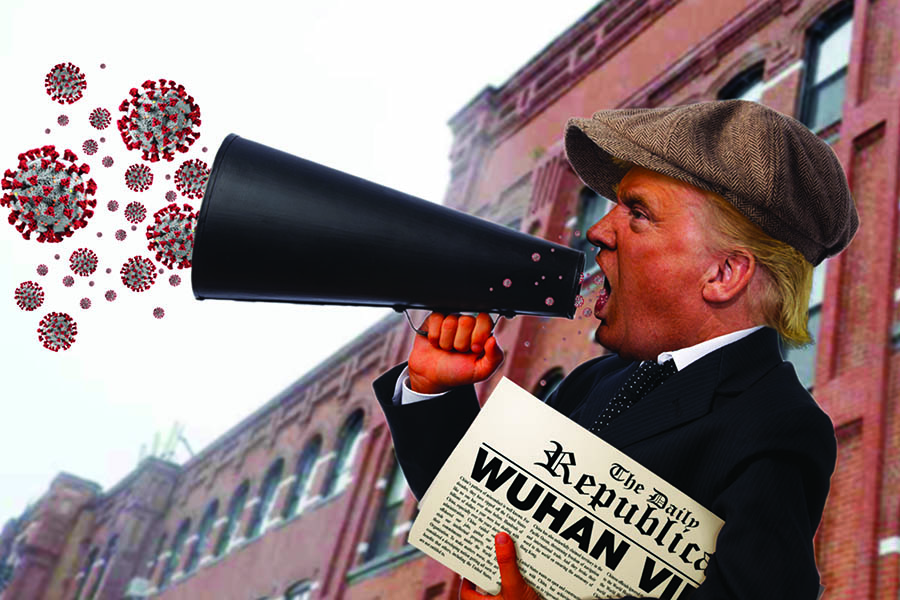
The COVID-19 Pandemic has affected more than health in the United States. Many concerns that have arisen are not new, but renewed. A divide as old as this nation's founding, concerns race as a measurement of an individual. Systems in place to hold black and brown peoples are being both highlighted and challenged. Blatant racism has found a voice and an audience. Economic divides showcase what the “American Dream” might really embody. Promise of support and governance is lacking as a consistent message is absent in leadership. Individuals bear the burden, forced to make decisions on their own, overworked, and sometimes paying with their lives as the virus spreads.
I've chosen to depict Donald Trump in three different situations that parody, leadership during this health crisis and national unrest. Although hardly responsible for Covid-19 himself, his actions have divided this country and caused the needless deaths of many.
In "Ball Pit," Donald Trump falls backwards into a children’s play area, filled with plastic balls - in reality enlarged versions of the Covid-19 virus. He smiles as he falls, feeling protected himself. Across the nation, people die. "Newsboy" depicts Donald Trump as a stereotypical 1940s newspaper boy. This childlike man shouts his message through a bullhorn, spreading the Covid-19 virus, both literally and in his speech - sowing disinformation, partisan politics, social divide, racism, and fear.
A nod to the real-life healthcare professional as depicted by actor Robin Williams, "Patch Adams" features a group of healthcare workers. They stand in a row, dressed from head to toe in protective equipment, sharing hand gestures of love. Donald Trump poses as if he is one of them, unprotected, smiling, as he wears the red-nose of a clown - the false nose itself an enlarged Covid-19 virus.
If leadership is failing to offer support to the majority of people in this country, what can we do as individuals? How can we support others? How can we support causes? How can we make changes? It may start as simply as wearing a mask, to protect those around you, and yourself. The rest is up to you.
Digital images were sourced from the internet, compiled together, and altered with Adobe Photoshop.

::: top :::
Abby Schrup

This series started with the Mask piece, and expanded to show what else I have been doing during the pandemic: reading, gardening, and as seen through my selected medium— stitching.
As an introvert, social distancing is right up my alley!
::: top :::